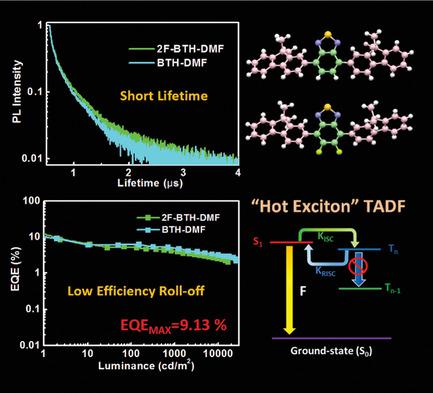当前位置:
X-MOL 学术
›
Adv. Opt. Mater.
›
论文详情
Our official English website, www.x-mol.net, welcomes your
feedback! (Note: you will need to create a separate account there.)
Experimental Evidence for “Hot Exciton” Thermally Activated Delayed Fluorescence Emitters
Advanced Optical Materials ( IF 8.0 ) Pub Date : 2018-12-14 , DOI: 10.1002/adom.201801190 Jianjun Liu 1, 2 , Zhiyi Li 1, 2 , Taiping Hu 3 , Xiaofang Wei 1, 2 , Ruifang Wang 1, 2 , Xiaoxiao Hu 1, 2 , Yanwei Liu 1, 2 , Yuanping Yi 3 , Yukiko Yamada‐Takamura 4 , Ying Wang 1, 2 , Pengfei Wang 1, 2
Advanced Optical Materials ( IF 8.0 ) Pub Date : 2018-12-14 , DOI: 10.1002/adom.201801190 Jianjun Liu 1, 2 , Zhiyi Li 1, 2 , Taiping Hu 3 , Xiaofang Wei 1, 2 , Ruifang Wang 1, 2 , Xiaoxiao Hu 1, 2 , Yanwei Liu 1, 2 , Yuanping Yi 3 , Yukiko Yamada‐Takamura 4 , Ying Wang 1, 2 , Pengfei Wang 1, 2
Affiliation

|
Contradiction between no effective photophysical experiments and high device results causes the “hot exciton” thermally activated delayed fluorescence (TADF) mechanism to be still a controversial question. Here, the steady and transient photophysical characterization combined with theoretical calculation based on 4,7‐bis(9,9‐dimethyl‐9H‐fluoren‐2‐yl)‐5,6‐difluorobenzo [c][1,2,5]thiadiazole (2F‐BTH‐DMF), 4,7‐bis(9,9‐dimethyl‐9H‐fluoren‐2‐yl)benzo[c][1,2,5]thiadiazole (BTH‐DMF), and 5,6‐bis(9,9‐dimethyl‐9H‐fluoren‐2‐yl)benzo[c][1,2,5] thiadiazole (o‐BTH‐DMF) demonstrate that all the emitters exhibit TADF via reverse intersystem crossing (RISC) from “hot exciton” triplet excited state. The fast RISC process “hot exciton” mechanism affords a very short delayed lifetime (1 µs). Organic light‐emitting diodes (OLEDs) based on these emitters exhibit high exciton utilization over 25% and the best device shows a maximum current efficiency of 31.02 cd A−1, maximum power efficiency of 27.85 lm W−1, and external quantum efficiency of 9.13%, which are the highest performances for reported OLEDs with “hot exciton” mechanism. The experimental evidence for fast RISC process via “hot exciton” triplet state and short delayed lifetime highlights the TADF emitters with “hot exciton” mechanism for high‐performance OLEDs with very low efficiency roll‐off.
中文翻译:

“热激子”热激活延迟荧光发射体的实验证据
没有有效的光物理实验和高设备结果之间的矛盾导致“热激子”热激活延迟荧光(TADF)机制仍然是一个有争议的问题。在这里,基于4,7-双(9,9-二甲基-9H-芴-2-基)-5,6-二氟苯并[c] [1,2,5]的理论计算与稳态和瞬态光物理特征相结合噻二唑(2F-BTH-DMF),4,7-双(9,9-二甲基-9H-芴-2-基)苯并[c] [1,2,5]噻二唑(BTH-DMF)和5 6-双(9,9-二甲基-9H-芴-2-基)苯并[c] [1,2,5]噻二唑(o-BTH-DMF)表明,所有发射体均通过逆系统间交叉(RISC)表现出TADF )从“热激子”三重态激发态。快速的RISC过程“热激子”机制可提供非常短的延迟寿命(1 µs)。-1,最大功率效率为27.85 lm W -1,外部量子效率为9.13%,是已报道的具有“热激子”机制的OLED的最高性能。通过“热激子”三重态和较短的延迟寿命实现快速RISC工艺的实验证据突显了具有“热激子”机制的TADF发射器适用于效率非常低的滚降的高性能OLED。
更新日期:2018-12-14
中文翻译:

“热激子”热激活延迟荧光发射体的实验证据
没有有效的光物理实验和高设备结果之间的矛盾导致“热激子”热激活延迟荧光(TADF)机制仍然是一个有争议的问题。在这里,基于4,7-双(9,9-二甲基-9H-芴-2-基)-5,6-二氟苯并[c] [1,2,5]的理论计算与稳态和瞬态光物理特征相结合噻二唑(2F-BTH-DMF),4,7-双(9,9-二甲基-9H-芴-2-基)苯并[c] [1,2,5]噻二唑(BTH-DMF)和5 6-双(9,9-二甲基-9H-芴-2-基)苯并[c] [1,2,5]噻二唑(o-BTH-DMF)表明,所有发射体均通过逆系统间交叉(RISC)表现出TADF )从“热激子”三重态激发态。快速的RISC过程“热激子”机制可提供非常短的延迟寿命(1 µs)。-1,最大功率效率为27.85 lm W -1,外部量子效率为9.13%,是已报道的具有“热激子”机制的OLED的最高性能。通过“热激子”三重态和较短的延迟寿命实现快速RISC工艺的实验证据突显了具有“热激子”机制的TADF发射器适用于效率非常低的滚降的高性能OLED。











































 京公网安备 11010802027423号
京公网安备 11010802027423号